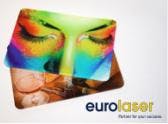Luneburg, Germany - Routine cutting of printed acrylic materials has always posed a challenge in terms of print quality, the precision of the cut, and keeping the print clean at the cut edge
In cooperation with Canon Deutschland GmbH, eurolaser, a German laser system manufacturer, has investigated this topic in a series of tests on the laser's suitability for cutting printed acrylic glass and printed polyester foils. In this test, the focus was made on the ink rather than the material.
Using an optical detection system, consisting of a CCD camera and evaluation software, eurolaser was able to guarantee high precision. The camera identifies a printed fiducial mark and calculates the position of the material automatically, correspondingly adjusting the cutting contours. For this reason, the laser test concentrated predominantly on the quality of the cut edge.
Laser cutting printed acrylic
The aim in the tests of laser cutting printed acrylic was to produce smoke-free cut edges, especially on white printed surfaces, with no damage to the print at the cut edge, and crystal-clear polished cut edges without post-processing.
For the tests, a 3-mm acrylic sheet was used that was printed on a Canon Oce Arizona flatbed printer using IJC 298 ink. A eurolaser M-800 system powered by a 200-W CO2 laser was employed.
All of the aims outlined above were achieved in the test. The cut edges showed no smoke residue, meaning that the white back remained faultless. Laser cutting caused no damage to the applied ink. This means the print quality remained excellent right up to the cut edge. There was no need for polishing or post-processing the cut edge as the laser automatically achieved the desired smooth cut edge in one pass. The conclusion — using a laser for cutting printed acrylic, combined with Canon IJC 298 ink — achieved needed results.
Laser cutting printed film
For laser cutting printed film, the goal was to test the ink for laser cutting compatibility with no resulting peeling of the print at the cut edge and no blistering. For these tests, the material used was 0.2-mm thick film sheet. The printer was a Canon Oce Arizona flatbed printer using IJC 296 ink. The laser cutter was a eurolaser M-800 using a 60-W CO2 laser.
In the test, eurolaser wanted to prove that digital printing is also suitable for industrial production and that printed films can be successfully cut by laser. Without the limitations of the five or six colors used in screen printing, digital printing systems such as the Oce Arizona provide for a range of color combinations.
The test achieved excellent cut edges. The fast drying process of the ink in conjunction with the heat development at the cut edge due to the laser process produced no ink peeling or blistering. Using the IJC 296 ink in the digital printing of membrane keyboards in conjunction with eurolaser cutting technology significantly increased process flexibility, achieving needed results, economically, even on short runs or prototypes.
Further test results illustrate that a diversity of printed materials can be successfully cut by the laser. Examples are textile materials, MDF, wood, SMART-X, paper/cardboard, and plastic foils.
